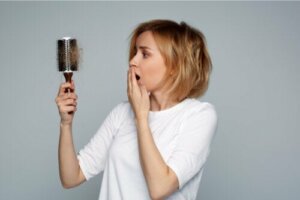How to Deal with Hair Loss While Breastfeeding

Women may experience hair loss while breastfeeding. However, breastfeeding itself doesn’t cause this, but, rather, a process that coincides with breastfeeding. The postpartum period or puerperium is the real culprit for the massive hair loss that some women experience.
Normally, you lose between 50 and 100 hairs every day. In the first 3 months after a baby is born, you lose a lot more hair. Therefore, this phenomenon is a myth that people blame on breastfeeding.
Causes of hair loss while breastfeeding
It’s natural for hair to fall out. In fact, it’s part of the natural hair cycle. The growth lasts between 2 and 3 years and is asynchronous, which means that not all hair grows at the same, nor does it fall out at the same time.
During the cycle, 90% of the hair is growing and between 10% and 15% is in a resting phase. That resting hair falls out, and new ones begin to grow.
So, it’s normal for hair to fall out. However, during pregnancy and postpartum, there’s a change in the normal cycle. The hormones that your body secretes during pregnancy produces accelerated hair growth, causing it to fall out less.
Then, after you give birth, you’ll lose the hair that didn’t fall out during pregnancy. This phenomenon, known in medicine as telogen effluvium, is normal and reversible.
Tricks to minimize hair loss while breastfeeding
Although you can’t stop hair loss during breastfeeding because it’s a normal process, you can minimize it by following some natural tips to take care of your hair in that period of time.
1. Get vitamin B
Vitamin B6 is a great hair ally. In fact, according to Palafox Virgil, taking vitamin B6 orally helps improve hair loss. However, your doctor should prescribe you these supplements.
Remember, vitamin B is a group that includes vitamin B1 (thiamine), B2 (riboflavin), B3 (niacin), B5 (pantothenic acid), B6 (pyridoxine) and B7 (biotin). Also, B9 is folic acid and B12 is cobalamin.
The B6, B7 and B12 are the most recognized for hair care. In addition, they all fulfill important roles in the body, such as obtaining energy from food.

Also read: Vitamin B Can Help Preserve Cognitive Function
2. Eat better
To reduce hair loss, it’s also important for you to pay special attention to your diet. Following the previous section and without taking any types of supplements or pills, you can increase your consumption of vitamin B by including it in your diet.
There are lots of foods that include it. Mainly, fish has lots of B12. Some of the most recommended are sardines with 8.9 micrograms of vitamin B12.
Legumes (lentils, beans and lima beans) contain between 444 and 482 micrograms of vitamin B9 or folic acid. Under normal conditions, it’s recommended to consume around 400 micrograms every day.
The liver and other cow organs, such as kidneys, also contain lots of B vitamins. In fact, in 100 grams of liver, there are 80 micrograms of vitamin B12.
3. Massage your scalp
Make sure you do this properly. First, you must know what type of hair you have, either dry or greasy. By massaging it, you can stimulate the sebaceous glands, which help keep the skin lubricated.
If you have oily hair that produces lots of sebum, you should massage with the palm of your hands so you don’t stimulate the glands. If you have dry hair massage with your fingertips. Then, massage in circles gently for 2 or 3 minutes.

Check this out: Can Hair Fall Out Because of the Keto Diet?
4. What about beauty treatments?
During this period, it’s best to use soft and hair-friendly products, with a neutral pH. If you want to dye your hair, it’s best to talk to a specialist about it.
Remember, your scalp is going through a delicate phase and dyes, shampoos, and conditioners contain chemicals that can impact your hair’s health.
Hair loss during breastfeeding is temporary
Either way, this should be a passing and normal phase for all postpartum women. However, if you think it’s been going on for too long and the hair loss is excessive, you can ask a dermatologist.
All cited sources were thoroughly reviewed by our team to ensure their quality, reliability, currency, and validity. The bibliography of this article was considered reliable and of academic or scientific accuracy.
- Suro J. El pelo. Generalidades y funciones. Dermatología Cosmética, Médica y Quirúrgica. Volumen 5 / Número 4 / octubre-diciembre 2007. Consultado 18/02/2021. Disponible en: https://www.medigraphic.com/pdfs/cosmetica/dcm-2007/dcm074g.pdf
- Palafox-Vigil G, García-Esquivel MA, Galván-Martínez S. Antioxidantes y pelo. Dermatol Rev Mex
2015;59:421-429. Disponible en: https://www.medigraphic.com/pdfs/derrevmex/rmd-2015/rmd155j.pdf - Lobo, Betty Vásquez, and Armando J. Vásquez Lobo. “Piel y embarazo.” MedUNAB 5.14 (2002): 83-99.
This text is provided for informational purposes only and does not replace consultation with a professional. If in doubt, consult your specialist.








